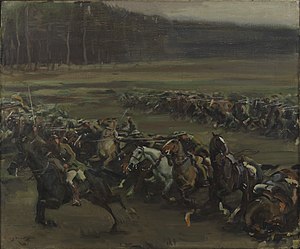Battle of Moreuil Wood
| Battle of Moreuil Wood | |||||||
|---|---|---|---|---|---|---|---|
| Part of World War I | |||||||
 Charge of Flowerdew's Squadron by Alfred Munnings portraying the Allied cavalry attack against the Germans at Moreuil Wood. |
|||||||
|
|||||||
| Belligerents | |||||||
|
|
|
||||||
| Commanders and leaders | |||||||
| General J. E. B. Seely, 1st Baron Mottistone | General Erich Ludendorff | ||||||
| Casualties and losses | |||||||
| 305 | Casualties are uncertain. | ||||||
|
|
|
|
|
The Battle of Moreuil Wood (30 March 1918) was an engagement of World War I that took place on the banks of the Arve River in France, where the Canadian Cavalry Brigade attacked and forced the German 23rd Saxon Division to withdraw from Moreuil Wood, a commanding position on the river bank. This defeat at the hands of the Allies contributed to the halt of the German Spring Offensive of 1918. During the battle, a Victoria Cross was awarded to Canadian Gordon Flowerdew of Lord Strathcona's Horse.
By March 1918, the three years of stalemate seen in the First World War on the Western Front were about to end.
Russia had departed from the war thanks to the Bolshevik Revolution and peace negotiations, the United States had not yet established a strong fighting force in Europe, and the French Army had suffered heavily, and had disbanded many divisions in order to keep others fully manned. This left the British forces as the most formidable on the Western Front, but they had vital reinforcements withheld by the Prime Minister David Lloyd George, who was concerned that the British Expeditionary Force commander, Field Marshal Sir Douglas Haig would feed them into a slaughter like those of 1916 and 1917.
With divisions freed up by the winding-down of the Eastern Front and victory against the Italians at Caporetto, General Erich Ludendorff of the German High Command thought the time ripe for a successful offensive. Much of the German Army in the west consisted of worn-out "trench" divisions, but the spearhead German divisions were fully manned, well equipped, and experienced. Three German armies (2nd, 17th and 18th), would break through the weakest section of the Allied lines, the areas of the British 5th and 3rd Armies. On 21 March 1918, at 04:00 and under the cover of a heavy artillery barrage, the German offensive began. The British, part of whose defences was a 40 km long stretch of poorly prepared trenches recently taken over from the French, were quickly forced to withdraw.
...
Wikipedia
